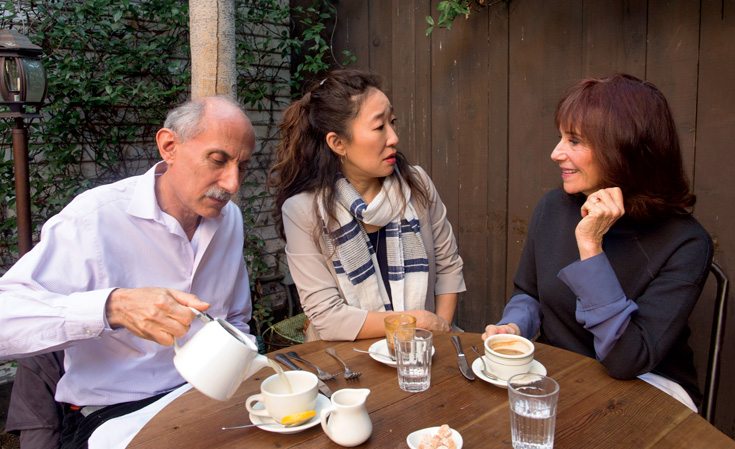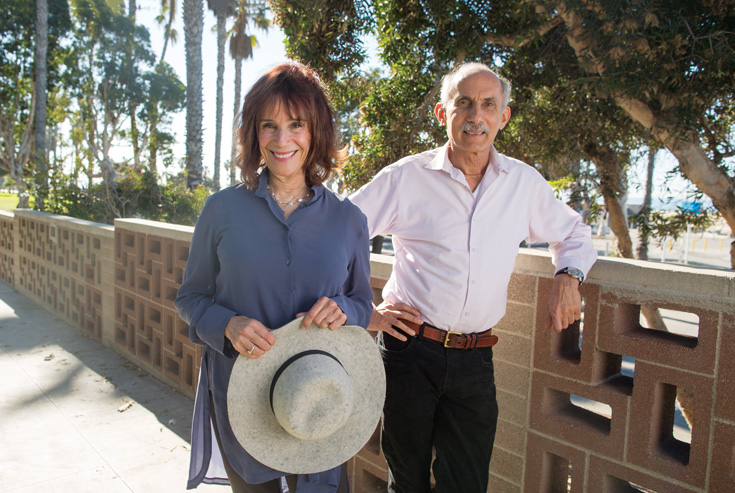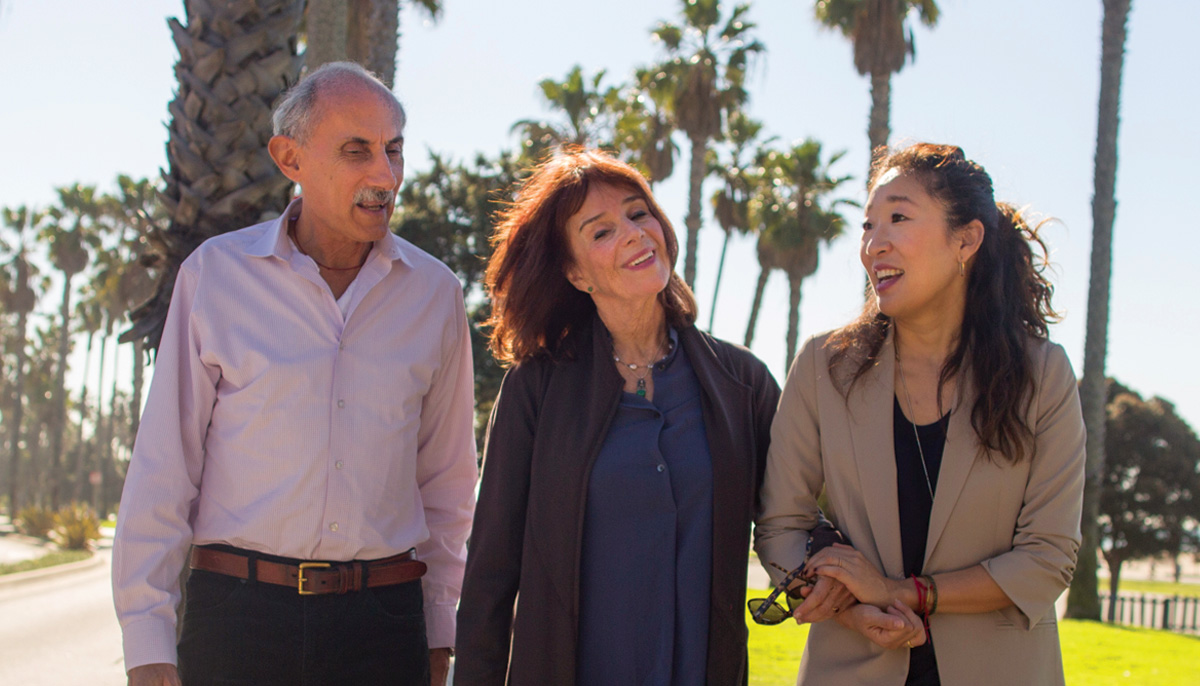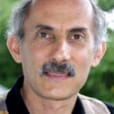Sandra Oh: Where is Buddhism going vis-a-vis American society? Where will it make its greatest contribution in this century?
Jack Kornfield: It’s a mysterious question, because no one has the answer. The impact is actually in the practices themselves—of compassion, loving-kindness, forgiveness, mindfulness, interdependence. The practices and their scientifically validated benefits are what is changing education, health care, arts, and athletics, etc. What’s really important is not whether someone becomes part of another religion or belief system but how they live.
No one knows exactly what form Western Buddhism is going to take, but there will be a new form, just as it became Zen in Japan or Vajrayana in Tibet. And we get to be part of seeing how that unfolds.
Trudy Goodman: Here is an example of how Buddhism is changing. At InsightLA, we had, as far as I know, the first ceremony in this country in which the dharma was transmitted through three generations of laywomen. It was a dharma blessing from Sharon Salzberg, who was present as one of my teachers, to me, and then to Christiane Wolf and Beth Sternlieb, who are students of mine who now teach. That represents a seachange in Buddhism.
At InsightLA, we have a people of color group, a dharma alliance group (which is LGBTQ) a sitting group of elderlies, young people, an eco-dharma group, and more. These are all things that I couldn’t have imagined early in my practice of the dharma.
Engaged compassion means making sure that practitioners who have been on the margins of American Buddhism are more fully represented in our communities. —Trudy Goodman
Jack Kornfield: In the 1960s, our generation of Insight teachers learned remarkable practices in Asia. One of the most important things that happened when we returned to America was that our Burmese and Thai teachers went home again after they visited us. They came, taught with us, saw what we were doing, and said, “This is good. You do it the American way.” Then they went home.
That was different than a Japanese Zen teacher or Tibetan lama who came to America to stay and establish their own center. You go to those places and they can feel, culturally, like you’re still in Japan or Tibet. In the Insight Meditation tradition, our teachers said, “You do it your American way.” That meant we were free to have people sit in chairs if they needed to, and not wear robes, and chant in English.
More importantly, we were free to bring Buddhism into the twentieth century. The essence remains emptiness and compassion, but in certain cultural forms Buddhism hadn’t changed since the Middle Ages. It was patriarchal and in some ways could be life-denying. The practices were often divided, where the monastics were the meditators and the lay community’s role was primarily support and devotion.
In our community it changed from being focused on monasteries—although now there are several fine ones in the West—to something that was very unusual in Asia: a Buddhist community that is predominantly lay teachers and lay practitioners who are committed to dharma practice and transforming their lives.
We have many fine women teachers. We have included relationship, emotion, and interpersonal understanding in the dharma. We have changed from a patriarchy to something much more democratic, in which teachers and other members of the community collectively hold the responsibility and wisdom.
The generation that Trudy and I represent has let go of some of the old cultural biases of Buddhism and brought it into twentieth-century forms. Now it’s the job of new generations of Buddhists to take it into the twenty-first century, in terms of greater technology, diversity, justice, social action, and so forth.
Sandra Oh: Where do you think dharma practitioners today should be concentrating their efforts?
Trudy Goodman: There’s definitely not a one-size-fits-all answer. Every dharma practitioner needs to know their strengths and vulnerabilities, which areas of their own lives need attention, which need more cultivation or development. And we teachers often teach what we ourselves need to learn how to embody more fully!
Overall, I think that in the future, meditators will be more aware of how they can integrate their contemplative lives—through getting to know themselves deeply—in ways that embody the full spectrum of their humanity. Then they can radiate a peaceful presence to all those whose lives they touch.
It takes courage to move out into the world—to work to heal oppression and violence in our culture. It’s courageous to extend our efforts in awareness to call for racial, social, and ecological justice. Engaged compassion means making sure that practitioners who have been on the margins of American Buddhism are more fully represented in our communities. What a joy and privilege it is to study with more Asian-American Buddhists, more Black and Brown teachers. To practice with all kinds of people from all walks of life, united in our love of the Earth, our ancestors, our children, and our descendants!
Jack Kornfield: I would also say that it’s good to pay attention to love. The ability to be present and to love is, in some ways, a measure of the practice, as well as its fruit. The growing capacity for love, loving-kindness, and compassion makes the heart freer and more able to embrace the joys and sorrows of life with wisdom. If you’re able to love and be present more fully, or at least notice what leads you in that direction, that’s something really worth paying attention to.
Sandra Oh: How do you feel your teaching has changed and grown over the years?
Jack Kornfield: I’m nicer than I used to be. The training that I had in Asia was warrior training. You sit up all night, you don’t move—the kind of classic thing that one studies in Zen or, in this case, ascetic forest monasteries. It was a fierce, ambitious striving approach that at times led me to push people and be judgmental when they wouldn’t or couldn’t do it.
The truth is that our psyches are very different in the West. Most people need to have a field of compassion and self-kindness before they can do something so demanding. I really had to learn that. That’s one way I’ve changed.
Trudy Goodman: I am not a born teacher, somebody who really likes being up there in front of everybody. For me, the dharma was a way to handle my own craziness. Once I was no longer afraid of my own mind, I realized that psychotherapy might be the career I was looking for. Without knowing it, I was going toward the intersection of meditation and psychotherapy, which in those days didn’t even exist.
Though people at InsightLA might have trouble believing this today, I was very shy and never saw myself as a dharma teacher. I had to find my own voice and confidence when I was teaching Zen. I was tougher then because that was the way we were trained. Then, when I joined the Insight Meditation community, I learned to teach in a different way. I think of it as the difference between poetry and prose, in which you really unpack what you’re saying. You make it clear. You don’t rely on resonance and metaphor to communicate. You make it explicit.
Sandra Oh: These days, Buddhism and mindfulness are both becoming more mainstream, which is great. What do you think makes a person gravitate to one or the other—Buddhism or secular mindfulness?
Trudy Goodman: Mindfulness is becoming integrated into so many sectors of society now that lots more people are using the tools and skills it offers. Everybody now hears that mindfulness is good for you, the way everybody knows that exercise is good for you.
Still, there are times when exercise is not the right thing, and we need to rest. Sometimes practicing mindfulness can be contraindicated, unless it’s carefully taught in ways that are sensitive to the specific situation.
At some point, people who want a deep dive into practice will have to find their way to a Buddhist meditation center and do a residential retreat. Soon, though, there will be mindfulness centers where you can take a deep dive into intensive retreat and discover the sacredness of secular mindfulness!

Sandra Oh: Do you ever think, “I’m not going to speak about the Buddhist teachings because I am concerned that many people are not ready to hear this?”
Jack Kornfield: It depends on the venue. In a lot of places, we’re invited because we are Buddhist teachers. But sometimes I speak at a large corporation or somewhere they specifically want mindfulness. Then I have to be careful, because people have other religious beliefs, or they may have religious injury, and putting things in religious terms is off-putting.
In any case, the essence of Buddhist teaching is not religion—it’s a science of mind. It’s a practical way to live with integrity, inner freedom, compassion, and well-being. I think people innately have a longing for something greater than the small sense of self that we find ourselves living in. You could call it a spiritual or sacred longing.
Sometimes people first connect with the sacred by walking in the mountains, and they realize that they’re part of something vast. Or they listen to an amazing piece of music or are present for the birth of a child. Then when they learn about meditation and mindfulness, they realize it’s a doorway to that world. It’s something that connects them to a mystery that’s greater than themselves.
Trudy Goodman: So many people are ripe to hear Buddhist teachings, especially the first noble truth. It takes them off the hook of shame and blame for their suffering! And the teachings of impermanence.
Yes, there certain places where it could be disrespectful or insensitive to talk about Buddhism. But we can be generous and imaginative; we can speak about Buddhist teachings in our own words, in whatever cultural vernacular we normally use. The Buddha encouraged teachers to speak in the language of their audience. That’s a direct challenge to our creativity and know-how—to attune to who’s listening and speak so everyone can feel included.
Sandra Oh: Do you think it’s natural for people in the West who are interested in the mind to veer toward a combination of Buddhism and psychology?
Trudy Goodman: Yes! What drew me to the study of both meditation and psychology was intense curiosity about how the mind works and what’s possible for the human heart. And here’s where I offer a bow of gratitude to psychotherapy, because it can really help clear away obstacles to caring for ourselves, each other, and our world.
There are areas of overlap between Buddhism and Western psychology, and there are areas of difference. That creates a powerful synergy when people combine them. There are radiant dimensions of awareness you can access in meditation that you aren’t going to reach in your psychotherapy. And there are things that aren’t going to be helped no matter how much you meditate, because things that happen to us in relationship generally need to be healed in relationship. It doesn’t just have to be in relationship to a psychotherapist; it can happen in a close friendship, or with a mentor or teacher, or in a loving, intimate relationship.
Jack Kornfield: As I got training in Western psychology, it was clear from early on how complementary and helpful psychotherapy was, not just for Buddhist practitioners but for teachers too. I began to see among the swamis and lamas and mamas and Zen masters in our industry that you could have a deep understanding of the dharma and still have areas that were completely undeveloped. The tools of Western psychotherapy allow you to become mindful and conscious in those areas that otherwise can hold a lot of suffering and mistakes.
People used to say, “If you do your meditation, it will take care of everything.” Those of us trying to integrate Buddhism and psychotherapy were put down—“Oh, this is low-class dharma.” Now I could tell you the names of the therapists of many of the abbots and Zen masters in America, because they’ve realized that it’s something that they need too.
Trudy Goodman: While it was natural for us Western students to combine therapy and dharma practice, at first it was baffling for our teachers, who came from different cultures in the East. After all, they were teaching Buddhist wisdom of the selfless!
In the 1980s, I was participating in a conference on Buddhism and psychotherapy that was held at a Tibetan monastery. The Rinpoche who was our host stepped up to the podium to welcome us, and you could see him searching for something to say. What he came up with was, “I suppose there are some few unfortunate individuals who would need to be in psychotherapy before they could practice the dharma.”
But by the end of the conference, the Rinpoche saw the important role that psychotherapy can play in human well-being. He had more openness and appreciation for the knowledge and wisdom we shared. Witnessing that transformation planted a seed for creating the Institute for Meditation and Psychotherapy years later.
Sandra Oh: How do Buddhist meditation and therapy work together?
Jack Kornfield: They are really a fine complement—if you have a good psychotherapist, and if you have a good meditation teacher.
In my monastic training, I learned many amazing tools of compassion and loving-kindness and mindfulness, but they were not so developed in terms of relationship. When I came back from Asia, I found, to my surprise, that my old habits—the fears, the neediness, the clinginess I had in my intimate relationships—all came back again.
I knew how to sit with my emotions and be mindful of them, but I didn’t know how to express them, which is another step in being free with them. It’s not enough just to be able to witness emotions. My therapists at the time called that the “monk’s defense”—you know how to feel your emotions, but you still don’t know how to express them and see that they’re just energies. I didn’t know how to do that.
Trudy Goodman: For me, it was exactly the other way around. Therapy came first. I felt too wild and unworthy, and while I longed to meditate, I was scared.
Therapy taught me how to be aware of my feelings and learn from them. It took a couple years of before I trusted my inner life enough to try sitting. I needed that bridge to actually get to meditation. And then it takes a lot of meditation to stay aware!
After only a few years of dharma practice, I gave a talk at the Cambridge Zen Center on Zen and psychoanalysis, about how each practice brings insight and a kind of quiet trust. It was 1976. Although I didn’t know it then, that was the beginning of my whole life’s work.
Jack Kornfield: Combining psychology with my Buddhist practice was profoundly healing personally, and as soon as I started teaching, I realized the same issues were coming up for other meditators. They needed to learn the Buddhist truths of impermanence and compassion and emptiness, but they also had to learn, as I did, about how to work skillfully with their trauma, fear, and confusion.
As Trudy said, that happens best in relationship. It takes two people—you can’t do it on your own. There’s a kind of paired meditation of attention that takes place, in which someone who’s wise and attentive, as a good therapist is, helps you pay deeper attention to what you’re experiencing. Often you start to pay attention to things that don’t even come up when you’re just sitting on your own. In therapy, there is this great, fruitful complement between two people.
Trudy Goodman: The synergy between Buddhism and psychology is so powerful. I used to wish that the people who came to see me in therapy would meditate. And I used to wish that my fellow meditators could have the chance to be in therapy. If the teacher looked at them sideways, they would be devastated. I remember feeling lucky that I got to work on my projections in therapy, so I could see a bit more clearly.

Sandra Oh: Speaking of relationship, how did you come to recognize each other as partners?
Jack Kornfield: After my marriage ended—and I had expected I would be married for the rest of my life, so it was not particularly easy—I thought, “Well, who would I like to be with? Who do I feel a connection and love with and who brings to me a kind of a joy?” Well, of course, Trudy.
Trudy Goodman: We were teaching together and working together. It was such a pleasure to discover we were on the same page. It happened very organically.
Somehow in my seventies I feel freer than ever to create and teach and sit and play. —Jack Kornfield
Sandra Oh: Any shareable future plans?
Jack Kornfield: Wow. I’m having a great time. Somehow in my seventies I feel freer than ever to create and teach and sit and play.
I’m just finishing a new book on freedom: inner freedom, outer freedom, freedom to love, freedom to create, freedom to start over, freedom beyond the self. I’m also recording new online courses and helping start a new national training program for teachers of color.
In Asia, I continue to work with folks in Burma. I support a project to bring young Buddhist leaders from across Asia together at Nalanda in India, and a project in China we call Returning the Treasure—working with Chinese Buddhists to bring dharma back alive after so much was lost in the Cultural Revolution.
Best of all, I get to do all this as work and love and travel with Trudy.
Trudy Goodman: One of the most astonishing projects I’m involved in at InsightLA is a canyon refuge in the stillness of nature—right in the heart of Los Angeles. It’s currently very rustic, but I’m excited about creating a precious resource to serve the community. I’m planning to do a retreat there in March.
We have a new Guiding Teacher Council at InsightLA that will give me more time for mentoring newer teachers, silent retreat, spending time with Jack and my grandkids, and swimming in the ocean!
My shareable plans are: love. Love Jack. Love my family. Love InsightLA (my other family) and everyone who makes it come alive. I’m loving life in the form of this incarnation, right here, right now.

